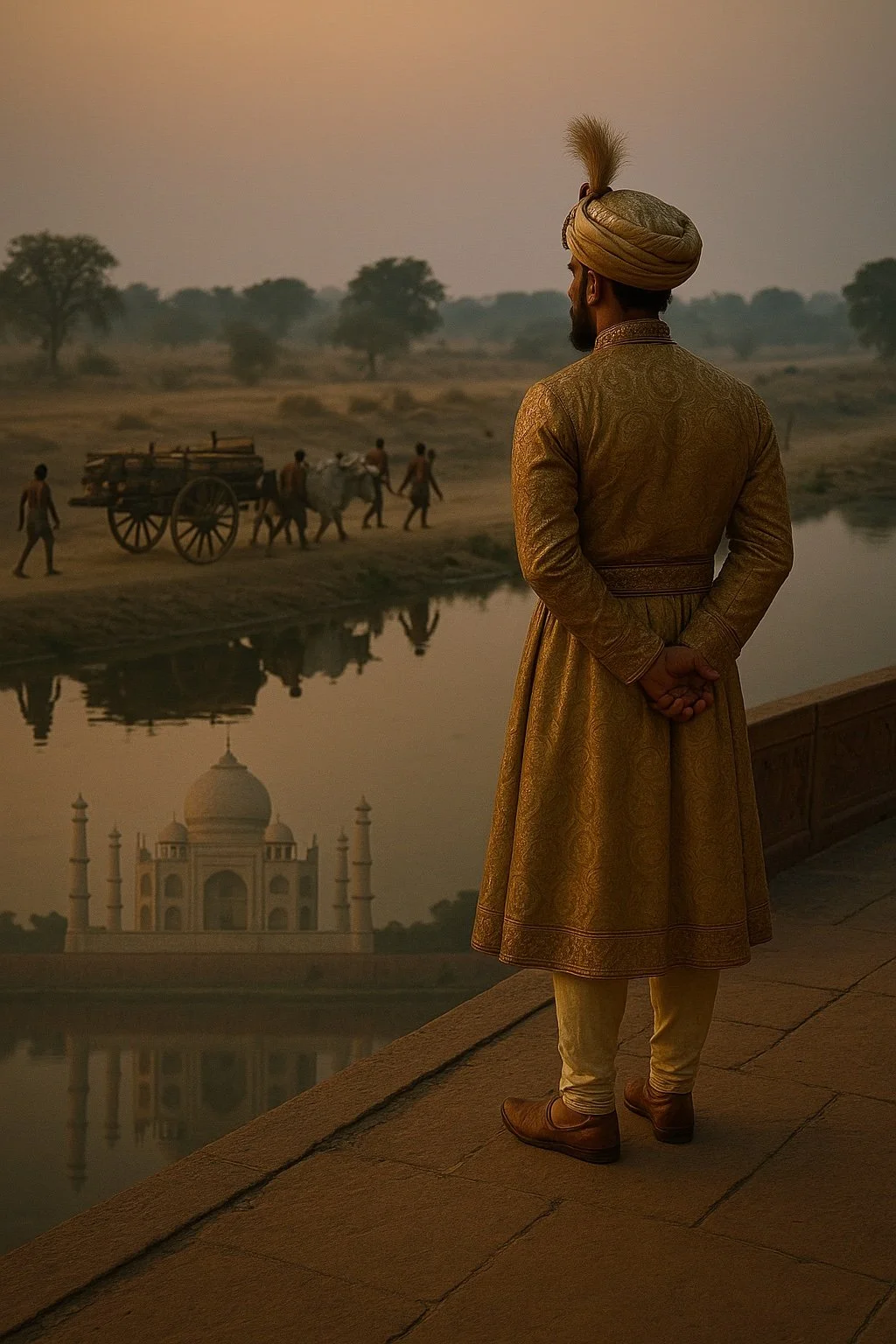SHAH-JAHAN
WHO WAS SHAH JAHAN?
Shah Jahan, the fifth Mughal emperor, is best known for commissioning the Taj Mahal - but his reign was far more complex than this singular achievement. He was born in 1592 as Prince Mirza Shihab-ud-Din Muhammad Khurram, the third son of Emperor Jahangir. He came to power in 1628 after a turbulent succession. Shah Jahan's reign lasted 30 years (1628 - 1658), marked the Mughal Empire's cultural peak but also its first significant cracks, particularly in regions like Punjab.
EARLY LIFE: THE MAKING OF AN EMPEROR
Shah Jahan's early life was shaped by the Mughal court. As the son of Jahangir, Prince Khurram grew up witnessing political and familial rivalries. His early exposure to military campaigns under Jahangir allowed him to develop into a capable commander, especially during conflicts in the Deccan.
However, Shah Jahan's ascension to the throne was not straightforward. The conflict within the Mughal family meant he had to fight his own brothers to secure the crown. After emerging victorious, he adopted the title Shah Jahan - King of the World and began his reign with grand ambitions.
SHAH JAHAN’S RULE: A TIME OF CULTURAL MAGNIFICENCE
Shah Jahan’s reign is often called the Golden Age of Mughal architecture. He commissioned several monumental structures, which showcased the Mughal Empire’s wealth and artistic sophistication, blending Persian, Indian, and Islamic styles into an architectural legacy.
Economically, Shah Jahan’s reign was characterised by relative stability in the early years, with trade flourishing across the empire. The empire's revenue system, established by Akbar and refined by Jahangir, supported an economy that thrived on agriculture and international trade. Punjab, as a fertile region and a crossroads of trade routes, played a crucial role in this prosperity.
MILITARY CAMPAIGNS AND CONTROL IN PUNJAB
For Shah Jahan, Punjab was both a strategic stronghold and a site of recurring unrest. The region's proximity to the empire's northwestern frontier meant it was critical for defence against external threats like the Central Asian Uzbeks and the Safavids of Persia. Shah Jahan launched multiple military campaigns in the region, aiming to consolidate Mughal authority.
However, Punjab under Shah Jahan also saw the rising tensions between the Mughal administration and the Sikh community. The execution of Guru Arjan Dev under Jahangir had already sown seeds of resistance. During Shah Jahan's reign, these tensions deepened as the Mughal authorities sought to suppress the growing influence of the Sikhs. Guru Hargobind - the sixth Sikh Guru, militarised the Sikh community in response to Mughal oppression, leading to open conflicts.
For the Punjabi population, Shah Jahan’s rule meant heavy taxation to fund his grand architectural projects and military campaigns. While these efforts showcased the empire’s might, they also burdened the local economy and strained relations with the region's communities.
THE DECLINE BEGINS: INTERNAL STRIFE AND LEGACY
Although Shah Jahan's reign is remembered for its splendour, it also exposed cracks in the Mughal administration. The vast expenditures on architectural projects and prolonged military campaigns drained the empire’s resources. Moreover, Shah Jahan’s later years were marked by internal strife. In 1658, his son Aurangzeb overthrew him in a coup, imprisoning him in the Agra Fort for the rest of his life.
From a Punjabi perspective, Shah Jahan’s reign was mixed. On one hand, his architectural achievements symbolised the peak of Mughal cultural influence; on the other, his policies exacerbated tensions in Punjab. The persecution of the Sikh community, the economic pressures of heavy taxation, and the military campaigns in the region alienated many Punjabis. These factors contributed to the growing resistance that would later culminate in the establishment of the Sikh Empire.
THE COMPLEX LEGACY OF SHAH JAHAN
Shah Jahan’s legacy is a paradox. While he is celebrated for the grandeur of his architectural achievements, his reign also marked the beginning of the Mughal Empire's decline. Punjab, a critical region during his rule, bore the brunt of his ambitions and excesses. The region's significance as an agricultural and trade hub ensured it remained a priority for the Mughals, but the heavy-handed policies of Shah Jahan alienated its people.
For Punjabis, Shah Jahan’s era is a reminder of the oppressive nature of Mughal rule, which often prioritised imperial glory over regional well-being. At the same time, the cultural and architectural contributions of his reign left an indelible mark on the subcontinent, illustrating the duality of his rule - magnificence and oppression.
In conclusion, Shah Jahan was a ruler of contradictions. His reign embodied both the heights of Mughal culture and the seeds of its eventual decline, particularly in Punjab, where resistance to Mughal authority would only grow stronger in the years to come.
A depiction of the dualities of Shah-Jahan’s reign - a peak in architecture, strain on the Punjabi population.
To Shah Jahan’s vision of grandeur, and to Punjab’s unbroken spirit in the shadow of empires.
With admiration – TrishSaab.